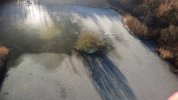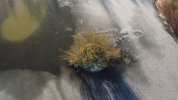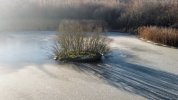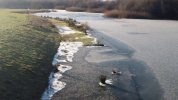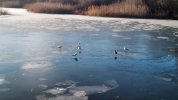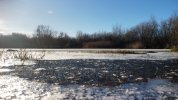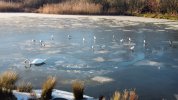You are using an out of date browser. It may not display this or other websites correctly.
You should upgrade or use an alternative browser.
You should upgrade or use an alternative browser.
Photos of frosty uk using cpl filter
- Thread starter mavicmaestro
- Start date
sarimento1
Well-Known Member
Nice
I don’t think the nd will reduce glare
In fact, in some cases you may want to keep the glare as a wintry element.
the mist is also nice touch
Have fun and safe flying!
I don’t think the nd will reduce glare
In fact, in some cases you may want to keep the glare as a wintry element.
the mist is also nice touch
Have fun and safe flying!
Garilla
Member
The problem is the 2nd, 3rd,and 4th images, which all have flare! This results from flying towards the sun. It would be difficult to edit out in Photoshop but you could give it a try. I would use the clone stamp, or the content aware fill tool under the edit menu.Nice
I don’t think the nd will reduce glare
In fact, in some cases you may want to keep the glare as a wintry element.
the mist is also nice touch
Have fun and safe flying!
ICHOTT
Well-Known Member
- Joined
- Jun 21, 2017
- Messages
- 395
- Reactions
- 315
- Age
- 71
ND filters are “neutral density” to differing degrees. They only ‘reduce’ the light input evenly, ie ‘neutral’, this is enable the photographer to use slower shutter speeds for whatever effect is wanted, it won’t change what you are asking.
For that you need a polarising filter , either linear or circular, google for explanation and examples
And well done for getting out and flying ?
For that you need a polarising filter , either linear or circular, google for explanation and examples
And well done for getting out and flying ?
An ND wont help glare. Leave them off for photos.
A CPL can help but not directly into or away from the sun (some of these images are directly into the sun). All you're going to get there is lens flare.
Those are pretty tough conditions for a low end/basic sensor. AEB bracketing might help a bit, especially if you start merging and blending in photoshop.
A CPL can help but not directly into or away from the sun (some of these images are directly into the sun). All you're going to get there is lens flare.
Those are pretty tough conditions for a low end/basic sensor. AEB bracketing might help a bit, especially if you start merging and blending in photoshop.
The biggest waste of money ever! I bought a set of Polar Pro polarizers. I rapidly discovered that unless I flew in a straight line at the correct angle of the sun I would avoid splotchy light and dark areas on my images. After a few bad outings, lesson learned. I have never used them again. I would never get a variable filter again.OP did say he was using a CPL. Probably wasn't oriented correctly for the glare that needs eliminating.
That's the problem with CPL on drones. It needs adjustment for the different angles you're flying and you can't adjust mid-air. Arms just aren't long enough.
CPL is the one essential filter i use on the drone.
Yes you need to set it up before flight but thats why you plan your shots in advance.
(and dont do panoramas).
I wouldnt fly without it anywhere with water or foliage.
Yes you need to set it up before flight but thats why you plan your shots in advance.
(and dont do panoramas).
I wouldnt fly without it anywhere with water or foliage.
Crouching Leopard
Well-Known Member
I believe ND filters are only for use in introducing video blur, but I could be wrongI used a cpl filter for this shot of a pond frozen
-1 degrees
I wonder if I used a nd8 filter to filter out the light the picture would be any better.
If I manipulated in photoshop could I make it so it was a nd filter 8.
View attachment 120396View attachment 120397View attachment 120398View attachment 120399
View attachment 120402
You're completely correct. They're for slowing the shutter speed to allow motion blur which for video is needed.I believe ND filters are only for use in introducing video blur, but I could be wrong
Its normally the opposite of what you want for stills.
ICHOTT
Well-Known Member
- Joined
- Jun 21, 2017
- Messages
- 395
- Reactions
- 315
- Age
- 71
Nah, your correction is incomplete.p, also crouching leopard.You're completely correct. They're for slowing the shutter speed to allow motion blur which for video is needed.
Its normally the opposite of what you want for stills.
To blur is one aim, the other is when the ambient light is just TOO bright eg snow / water scenes or looking towards the light, use ND to better control the exposure settings to get the effect you want of which motion blur is just one!
happy new year ??
Last edited:
ICHOTT
Well-Known Member
- Joined
- Jun 21, 2017
- Messages
- 395
- Reactions
- 315
- Age
- 71
Thank you for agreeing with me in that the OP does not need ND filters to address his questionNot unless you're attempting to photograph a nuclear blast its not.
M2P goes up to 1/8000th. Plenty fast enough for snow and water.
“I wonder if I used a nd8 filter to filter out the light the picture would be any better.”
?
inkytog
Well-Known Member
- Joined
- Jun 24, 2017
- Messages
- 173
- Reactions
- 82
- Age
- 50
You're completely correct. They're for slowing the shutter speed to allow motion blur which for video is needed.
Its normally the opposite of what you want for stills.
Not entirely true.
ND is used for stills photography just as much as video.
For instance- it can make flowing water look smooth, or introduce a small amount of motion blur to the water to give it some movement and feeling. Obviously the camera has to be on a tripod - and very still but the principal is the same. It’s essentially sunglasses for the lens. This means in bright sunlight you can shoot a slow shutter speed and a wide aperture for example - which you won’t be able to do even when a very low ISO setting.
In resent years the hobbyist has started to become obsessed with cinematic looks and with that the motion blur you see at the cinema.
Much like photography ND for video is used to keep the shutter at a setting - by allowing aperture and ISO values to be kept at the appropriate settings to give 24fps because people are obsessed with the ‘cinematic’ blur in movement .
Just what fraction of aerial photos are of silky waterfalls?!
Absolutely tiny.
99.99%+ are normal photos where the faster shutter speed is preferable. So no filter.
Wide aperture doesnt apply on (mavic) drones either.
Lets be realistic here - ND filters on a drone for still photos are virtually never what you actually want.
Absolutely tiny.
99.99%+ are normal photos where the faster shutter speed is preferable. So no filter.
Wide aperture doesnt apply on (mavic) drones either.
Lets be realistic here - ND filters on a drone for still photos are virtually never what you actually want.
inkytog
Well-Known Member
- Joined
- Jun 24, 2017
- Messages
- 173
- Reactions
- 82
- Age
- 50
Never what YOU actually want.. .perhaps not everyone.Just what fraction of aerial photos are of silky waterfalls?!
Absolutely tiny.
99.99%+ are normal photos where the faster shutter speed is preferable. So no filter.
Wide aperture doesnt apply on (mavic) drones either.
Lets be realistic here - ND filters on a drone for still photos are virtually never what you actually want.
You're also not taking Into account the 'sweet spot' of the camera lens. I agree a shallow DOF isn't achievable or needed etc BUT I'm sure you know every lens has a perfect aperture that gives the best quality/image information on the sensor. Rarely it's 2.8, more likely tot be somewhere between f4 and f8 - so an ND filter would certainly help you keep the f stop within the best dynamic range of the sensor.
Again we're talking mavics. Its well known.
On the drones where variable aperture there's very little difference between f/2.8 and f/4 (with f/4 on the M2 being the best..slightly) but from there onwards diffraction massively degrades image quality.
ND filters do absolutely nothing to increase or decrease dynamic range. They're a shaded bit of glass.
We're not talking large sensors, DSLRs or cameras on tripods here. We;re talking small sensor drones, some with variable apertures, some without.
Unless you're one of the 0.0001% who want to blur a waterfall, you're going to want the fastest shutter speed possible and that means no ND filter.
Shove it on ISO100, f/4 and unless you're trying to shoot a nuclear blast, the allowed shutter speeds will generate a good exposure with no filter at all.
On the drones where variable aperture there's very little difference between f/2.8 and f/4 (with f/4 on the M2 being the best..slightly) but from there onwards diffraction massively degrades image quality.
ND filters do absolutely nothing to increase or decrease dynamic range. They're a shaded bit of glass.
We're not talking large sensors, DSLRs or cameras on tripods here. We;re talking small sensor drones, some with variable apertures, some without.
Unless you're one of the 0.0001% who want to blur a waterfall, you're going to want the fastest shutter speed possible and that means no ND filter.
Shove it on ISO100, f/4 and unless you're trying to shoot a nuclear blast, the allowed shutter speeds will generate a good exposure with no filter at all.
inkytog
Well-Known Member
- Joined
- Jun 24, 2017
- Messages
- 173
- Reactions
- 82
- Age
- 50
Again we're talking mavics. Its well known.
On the drones where variable aperture there's very little difference between f/2.8 and f/4 (with f/4 on the M2 being the best..slightly) but from there onwards diffraction massively degrades image quality.
ND filters do absolutely nothing to increase or decrease dynamic range. They're a shaded bit of glass.
We're not talking large sensors, DSLRs or cameras on tripods here. We;re talking small sensor drones, some with variable apertures, some without.
Unless you're one of the 0.0001% who want to blur a waterfall, you're going to want the fastest shutter speed possible and that means no ND filter.
Shove it on ISO100, f/4 and unless you're trying to shoot a nuclear blast, the allowed shutter speeds will generate a good exposure with no filter at all.
It’s good that you know such accurate percentages.
Similar threads
- Replies
- 5
- Views
- 1K
- Replies
- 12
- Views
- 3K
- Replies
- 5
- Views
- 775
DJI Drone Deals
New Threads
-
-
-
REPAIR SOFTWARE FOR GIMBAL AFTER DIY REPAIRS
- Started by DroneWhisperer
- Replies: 0
-
-
Members online
Total: 995 (members: 7, guests: 988)




